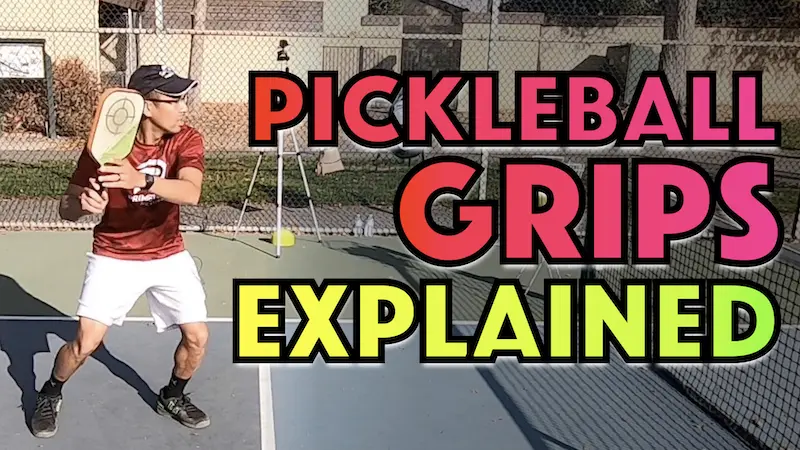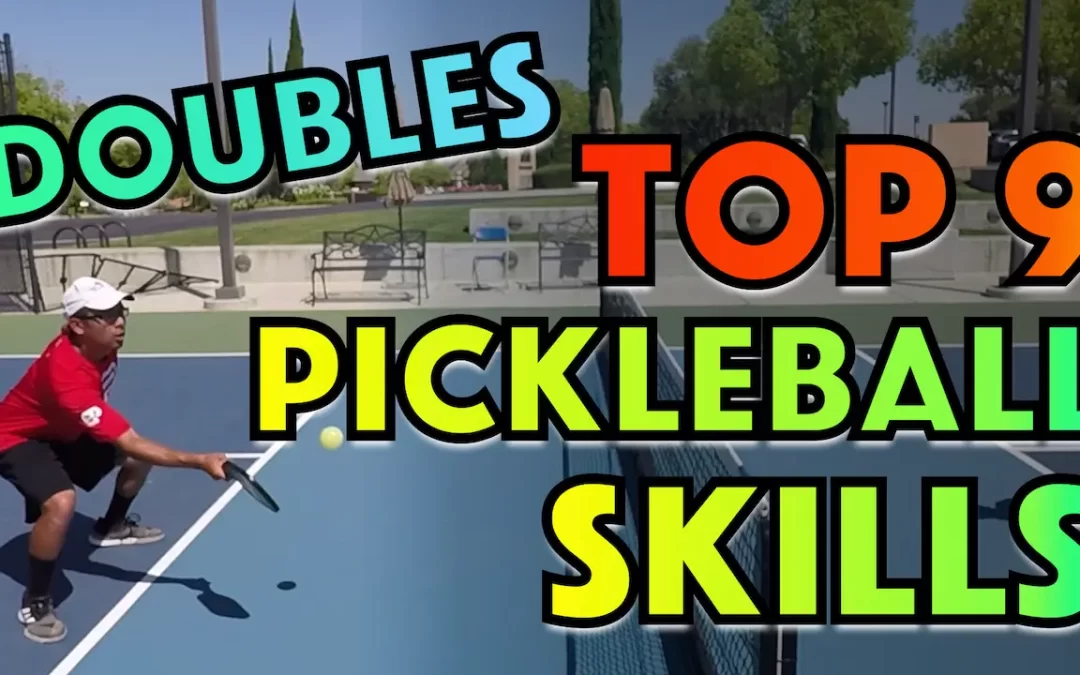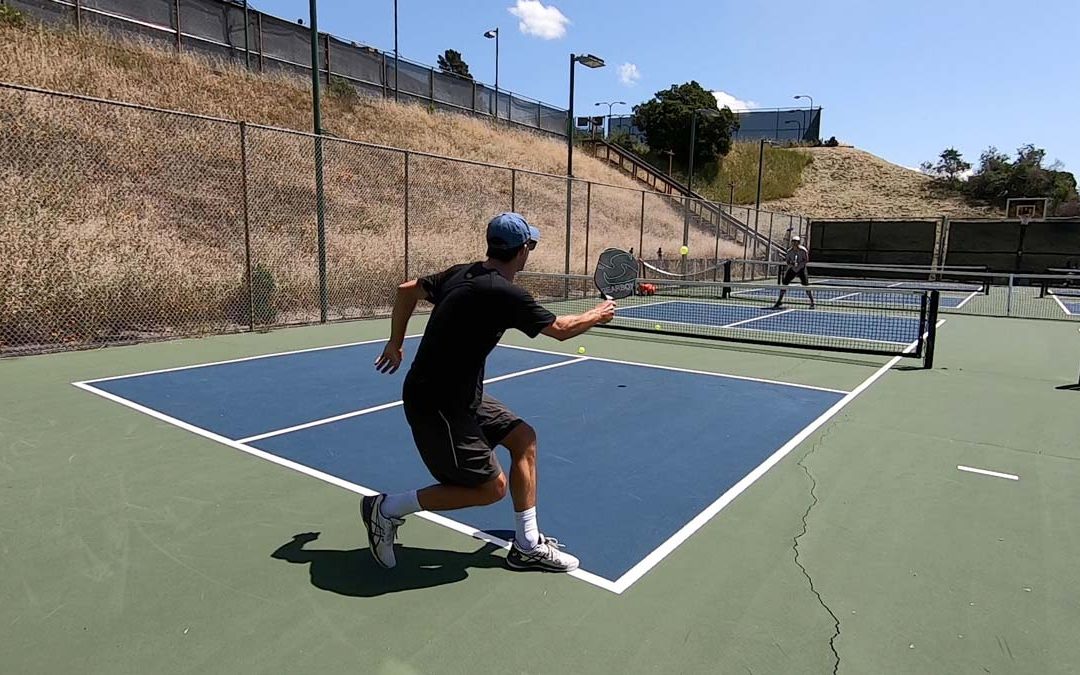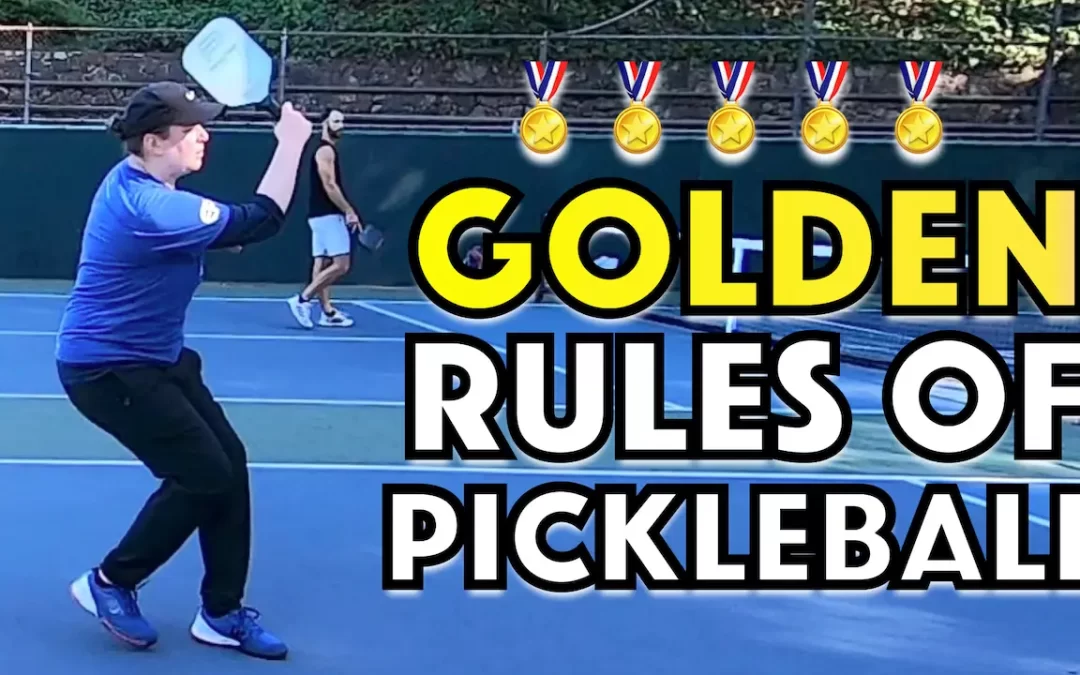PrimeTime Pickleball is thrilled to be a Title sponsor at the annual Engage Golden State Pickleball Championships that takes place in Concord, CA every July. The tournament is the biggest in Northern California.
The participants were maxed out at 500+ on just the 2nd annual holding of the tournament which is double what it was from the first year.
We also regularly have so many people come up to our booth and thank us for our pickleball videos and express how much their game has benefited from learning from them.
It is always music to our ears because that is exactly why we do what we do and to hear that we’re making an impact on people’s lives and to the sport makes us very happy and inspires us to continue in the pursuit of our mission.
With that in mind…we shifted gears a bit in our last few videos and it has been very well received.
We focused on STRATEGY!
We are so lucky to have been joined by Senior Pro, Helle Sparre, to help us with some awesome pickleball strategy videos.
Helle is the creator of the Dynamite Doubles System which she originally developed and successfully implemented to help countless tennis players win more in doubles.
She has tweaked and adapted her system for pickleball.
Clearly, her system works as she herself has used it to win many titles including the US Open and National Championships.
She now teaches her system to pickleball players across the country and is widely recognized as one of the best instructors around.
Helle shares some of the highlights of her system in this video/blog that focuses on how to (legally) isolate and frustrate an opponent leading their play to break down which ultimately result in more wins for you.
Specifically she will show us how she isolates and frustrates an opponent with advanced positioning and targeting strategies.
Before we jump on the court, it’s important to understand a few key terms and concepts that Helle will mention repeatedly as they are part of the building blocks of her dynamite doubles system.
What is “In Front Of The Ball” and “Across From the Ball”?
You are the player in front of the ball if the ball is on your opponents side straight ahead of you.
In this scenario, Player A is in front of the ball and Player B is across from the ball.
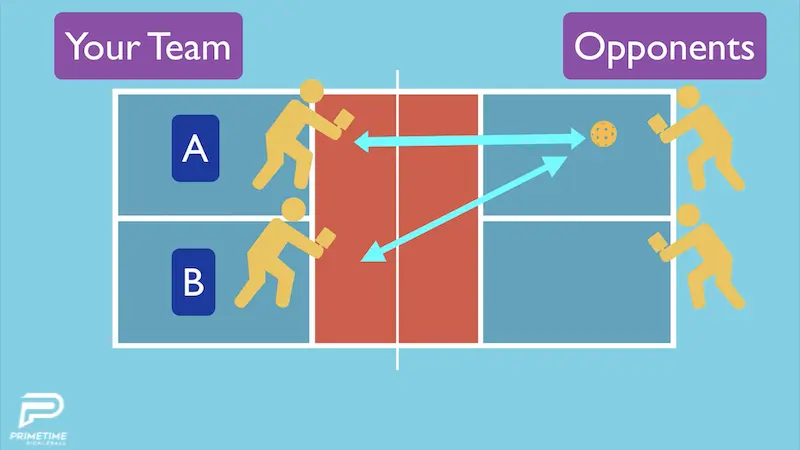
In this scenario, Player B is in front of the ball and Player A is across from the ball.
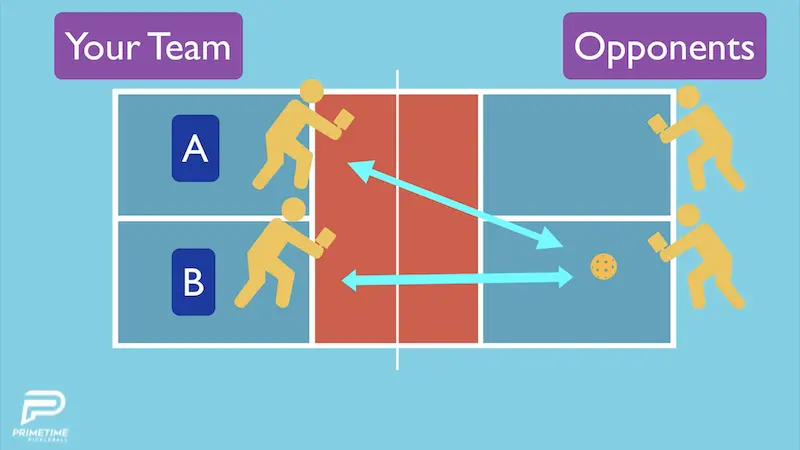
Who is the Terminator and Who is the Workhorse?
In Helle’s system, the player on your team that is in front of the ball is the terminator and is looking to be the aggressor, seeking to end points by finishing shots through the opposing player closest to them which will be the one straight ahead from them.
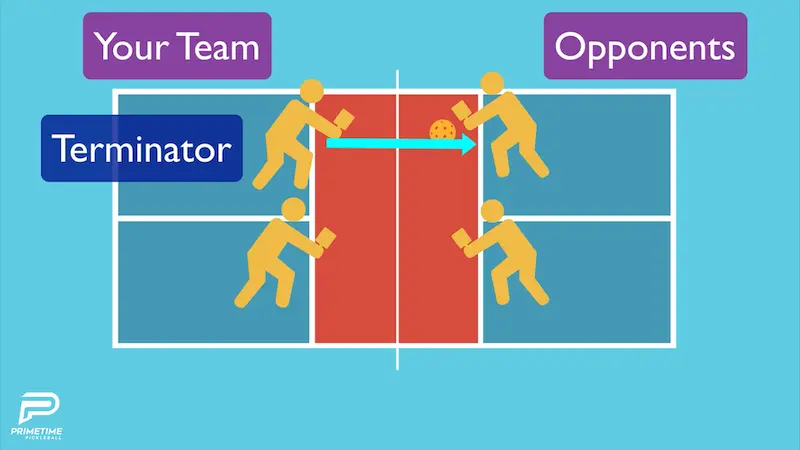
The workhorse, is the player on your team that is across from the ball. The workhorse is seeking to setup the terminator for the kill shot.
Here’s What Helle Has To Say…
I’m Helle Sparre and we’re going to try now and work on a return of serve and we’re going to play two against one. Where I’m returning determines who we are picking on.
In this case I’m going to hit it back to the server because as the serve is coming to me cross-court the highest percentage is back cross-court. That leaves my partner already in front of the ball.
It’s really important for the closest player to the line to be in front of the ball. If I hit it anywhere else but cross-court we’re not really in good position to cover the next shot.
We’ll go over that later when we get to that.
As I said before, the highest percentage shot I want to return back to the server. We’re going to isolate that person until we have a winner or until the dinking game happens.
The server has to earn it up there. If they don’t earn it we’re going to keep them back. That is our main objective.
Whoever we return to we want to keep them back and we want to both gang up on them.
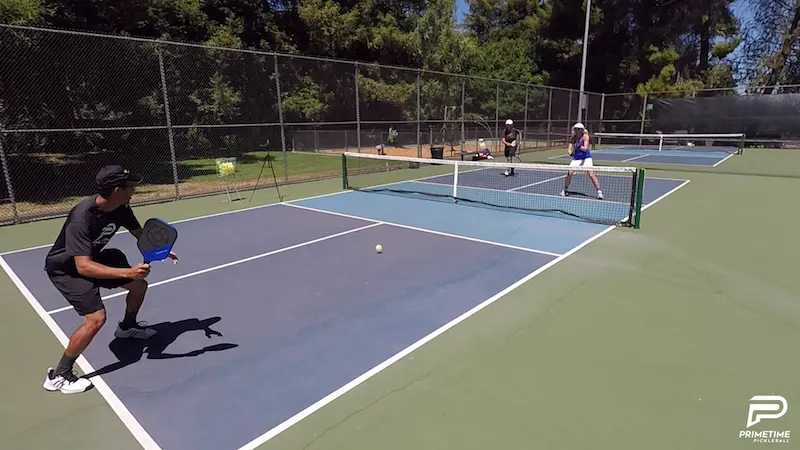
So we’re not going to anybody else then Jordan until we have the winning shot.
Jenny’s winning shot is at Jordan, my winning shot is straight ahead at his partner. In this example Jordan didn’t have a partner so I kept going to Jordan.
Both Jenny and I know who we’re going to.
Jenny’s winning shot is not diagonal or middle, it’s back at Jordan, because that’s the person who’s closest to her.
Most people will hit that backhand diagonal in the middle. The fact that Jenny went right at Jordan surprises him and it puts me in the right place should he get it because I’m facing this way (at Jordan) when Jenny is hitting it because it came from Jordan.
If she hits it at his partner I’m not going to be ready. I’m totally ready if Jordan gets this, even if he hits it hard in the middle. I will be there for her.
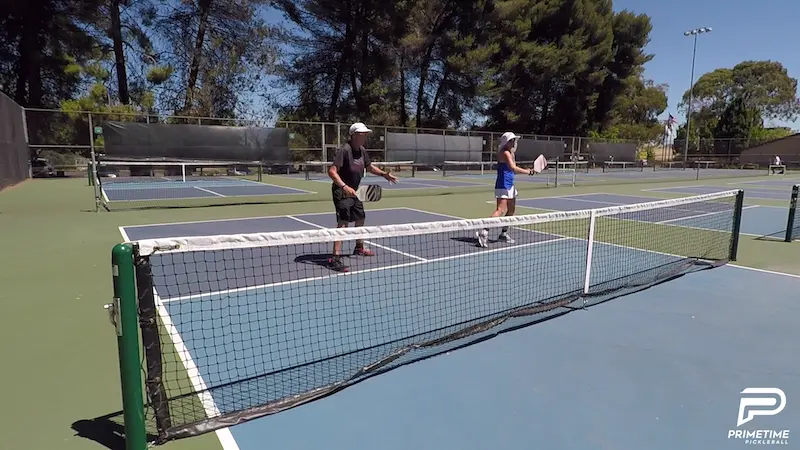
So when we return cross-court we have the middle covered.
Now, if I return in the middle and Jordan’s partner takes it, or if I return it down the line and his partner gets it, we are not positioned well.
We have the hole between us, temporarily.
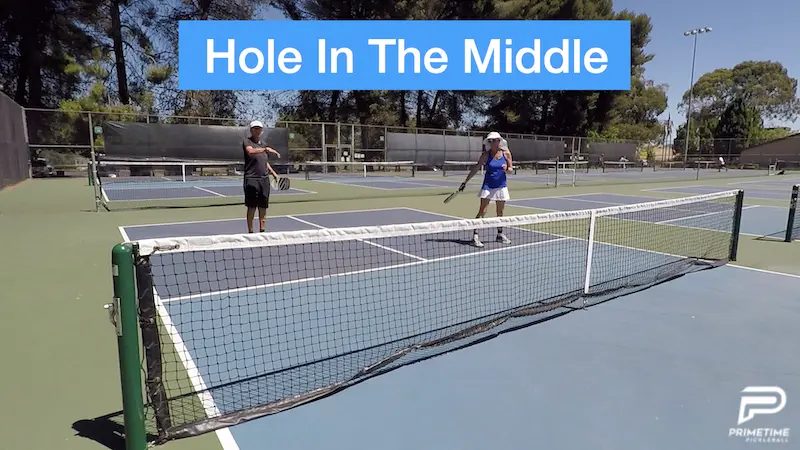
Jenny would come over face that way (towards Jordan’s partner) but it’s still open unless I get way up at the non volley zone line, fast, and can be in front of Jenny’s position on the court being the closer player.
So, if I return straight, I must speed up to the non-volley zone line to eliminate this bad hole that we want to avoid.
if Jordan has the ball we don’t have a hole, if his partner has the ball we have a bad hole right now.
There are two ways of covering that hole. Either I hurry up, get in front of Jenny, and I have first dibs in my narrow V right here, she backs me up.
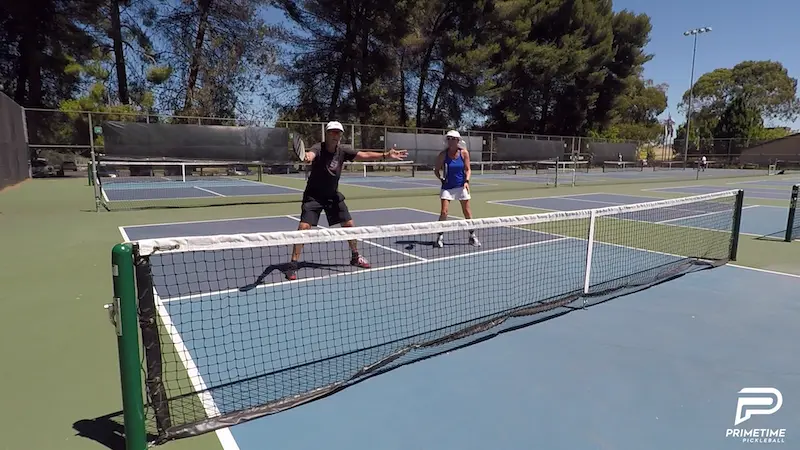
If Jenny’s trying to beat me here (up at the non-volley zone line) we would be fighting for the same ball. She has to let me come up here (at the non-volley zone line) and be the Terminator.
The other way would be.. let’s say I’m slow, Jenny would switch over, move over to my side of the court at the non-volley zone line and now we’re okay because the correct person is in front of the ball. The person closest to the kitchen is in front of the ball.
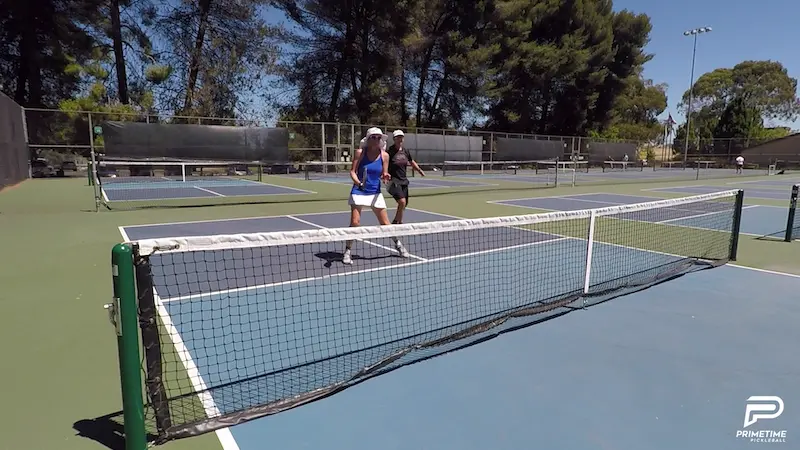
That’s an understanding you can have with your partnership.
The first run around I will come in really fast but I’m going to hit it straight ahead so Jordan will be stacking so he’s going to get that ball, Jenny covers the middle but allows me to come in front of her.
In the first example I’m going down the line, I’m hurrying in, I take it in front of Jenny.
Let’s do that again..and see again.. it’s going winning shot straight to Jenny, back to Jordan, reset.
So I’m going straight, I have to hurry in, take it first.
Now, in the second option, I’m tired of coming up so fast or I might be way out of the court, I’m going to call Jenny over so she can give me a signal for example, she can have an open hand indicating to me that “I go” and a closed hand indicating “I stay”.
So she shows me a signal and I acknowledge it.
She knows once I hit it I’m going to hit it down the line and she’s going to follow the ball.
The fact that Jenny hit it straight back helped me. If she had hit it over there (cross court) with me coming in we would have had a bad hole.
Since she hit it right in front of herself, I cannot be but in the right place.
If she hit it at a diagonal I’m messed up.
When you’re in front you hit it straight, when you’re a little behind you hit it in front of your partner that way you have coverage.
So that’s playing two against one with a little bit of movement. When we make this movement there’s so much for the other team to think about because they were going to hit it back to me and when Jenny moves over that (space) gets closed and then they have to change their mind and hit cross-court which is a difficult shot because it’s much easier hitting it back from where it came.
I really like this play because there’s movement and it gets that player (partner) involved.
Check out the video at the top of the post to see how this all works together to form winning pickleball strategy.
We want to send a big THANK YOU to Helle for sharing a highlight from her winning Pickleball Double system with us today.
If you want more information about Helle or want to get in touch with her please visit www.DynamiteDoubles.com
Get our free 3rd shot course here! –> 3rd Shot Drop Course


